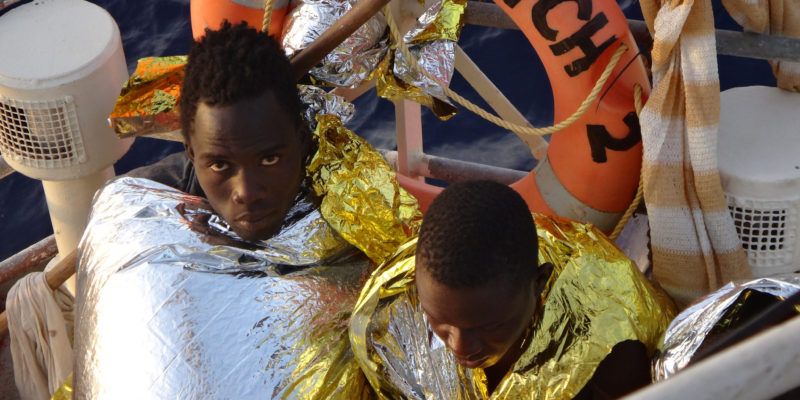1. Slavery in Libya. In real time
The hellscape of Libya that we now know too well, as told in real time by two Eritrean migrants who are trapped in it. Read the article by Fatma Naib in Al Jazeera.
2. The human cost of closing the Central Mediterranean route
The number of arrivals in Italy from Libya has dropped, but the death rate along the world’s most dangerous migrant route is getting higher. Last Sunday, the news broke out of yet another shipwreck, with three dead and at least twenty missing, while the NGOs have denounced how the Libyan Coast Guard interfered with rescue operations. Read the in-depth article by Priyanka Boghani in Frontline on the human cost of the EU’s response to the migrant crisis.
3. The Italian village fighting to keep its migrants, and the burning migrant camp in Rosarno
“Molise is not a thing”, said a meme from a few years ago. In fact, the small Italian region is very real, and has now been thrown in the spotlight thanks to the small town of Ripabattoni, whose entire population has opposed the closing of its migrant reception centre; read about it in Gianluca Mezzofiore’s article for CNN.
Things in Rosarno have not been as good for migrants. The makeshift camp for migrant labourers in the fields of Calabria, already known for the 2010 riots and its still appalling living conditions, was destroyed by a fire on the night of January 27. A young Nigerian woman was killed and many more were injured. A tragedy that could have been prevented, as Antonio Maria Miri’s article in Avvenire explains. See also the photo gallery in Repubblica and read this 2016 report in Internazionale).
4. Dodging death along the Alpine migrant passage
They are willing to do anything to pursue their journey of hope, even risking life in the attempt to cross the Alps in the dead of winter and the incessant snowfalls. We are talking again about the Alpine migrant route, leading from the Italian town of Bardonecchia (the “Lampedusa in the snow”) into France. There are growing concerns over migrants’ lives (their bodies might remain hidden in the snow, as Saskya Vandoorne and Melissa Bell wrote for CNN). The report by Annalisa Camilli (originally published in Internazionale) is now available in English on Refugees Deeply. Also read the report by ITV News and see the pictures by Antonio Masiello in the Guardian.
Dodging Death Along the Alpine Migrant Passage @refugeesdeeply https://t.co/ZWaTTlSs3K
— Border Criminologies (@BorderCrim) January 29, 2018
5. Follow the money: how countries are using the EU funds for migrants
The European Council on Refugees and Exiles (ECRE) and the UNHCR have mapped the implementation of the EU Asylum, Migration & Integration Fund (AMIF). The total budget established by the European Commission is over 3 billion euros, covering a period from 2014 and 2020, and the critical analysis has yielded interesting results. The UK, for instance, is the country that received more money than any other member state, and spent almost 60 percent of it on returning migrants. Read the article by Nikolaj Nielsen in EU Observer.
6. The lucrative business of fending off migrants
The same borders that kill – as we have written here, here and here – are a goldmine for some unscrupulous others. Read the investigative report by Laura Secorun Palet for Ozy on the big fat business of border control.
7. EU court: asylum seekers must not be forced to take ‘gay tests’
Asylum seekers must not be subjected to psychological tests to determine whether they are homosexual. It has been ruled by the European Court of Justice, following the case of a Nigerian national who saw his asylum application rejected in Hungary based on such a test. In the ruling, the Court said that such reports interfere with a person’s privacy. Read the article in BBC (as well as our own in-depth stories on LGBTI refugees in Europe).
No, LGBTI asylum seekers cannot see their claim denied on the basis of psycological tests [ECJ]. A positive step forward for #LGBTIrefugees https://t.co/4GauVm7RzY
— Luna Lara Liboni (@LunaLiboni) January 26, 2018
8. Israel and its refugees: history will judge
Israeli prime minister Netanyahu will do anything to drive African migrants from his country. Early in 2018, Israel gave the 40,000 Eritrean and Sudanese nationals who were denied asylum a choice: receive 3,500 dollars and leave or risk life in jail. The government, it has been announced, will hire civilian inspector who will be paid up to 9,000 dollars to hunt African migrants (as told in the article by Labdi Latif Dahir in Quartz). Criticism against Netanyahu’s directive has come in many forms from all over the world, including a letter signed by Holocaust survivors. Read the articles by Yehuda Bauer and by Gideon Levy in Haaretz, warning us that history will judge us if we don’t put an end to this injustice.
9. Fumbled repatriation sows fear in Bangladesh Rohingya camps
The repatriation of more than half a million Rohingya from Bangladesh to native Myanmar, where the ethnic cleansing campaign (directed mainly, but not only, against the Rohingya) rages on – has been postponed indefinitely. But in the refugee camps where hundreds of thousands of Rohingya are waiting, fear and uncertainty still run high. Read the article by Verena Hozl for Irin News, as well as our own report from Bangladesh and op-ed against the returns.
10. How Lebanon wants to return Syrian refugees to a war zone
The anti-refugee sentiment grows in Lebanon, making things harder for the 1.5 million Syrians who have fled the atrocities of war and tried to rebuild a life in the neighbouring country, even among many obstacles and uncertainties. Desperate Syrians may be forced to choose between staying in a place that doesn’t want them and returning to a broken country. Read the article by Eric Reidy in The Nation.
Foto di copertina via BB (CC BY-NC 2.0).









